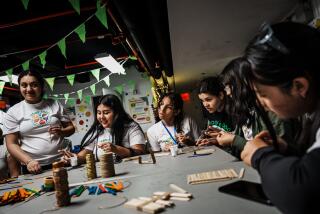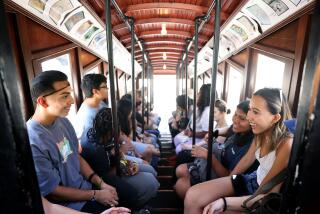Valley Perspective : Students’ Visit to Mexican Village Leaves Lasting Memory : Hoover High group moved by glimpse of extreme poverty
These days, according to Times reporter Lisa Leff, a group of students at Hoover High School in Glendale has a rich appreciation for the quality of their lives. They have a new energy, a new respect for the problems of the world around them, and a sense that they ought to be involved. Most importantly, perhaps, they now know what it really means to be desperate, angry, fearful and without hope. They also know how it feels to be needed.
The gift that provided this important “reality sandwich” was the students’ unforgettable 10-day trek to the harsh and impoverished high-desert village of Samachique, Mexico. Children were dying in this tiny Indian town situated in the unforgiving mountains of Chihuahua state in northern Mexico. A severe drought had threatened the village with mass starvation.
Some parents there were so desperate that they were willing to part with children because they could not feed them. A Hoover student watched a shoeless and barely clothed boy trying to warm himself by a dead fire.
It had been an art-appreciation class (of all things) taught by Pierre Odier, chairman of Hoover’s fine arts department, that had sparked the students’ interest Samachique and its Tarahumara Indians.
Before long, Odier’s students had organized collection drives to pay for the $9,000 spring-break trip, a truck and 4 tons of clothing, food, medicine, toys, farming tools and school supplies. That alone had been a substantive achievement. Yet after their trip, the Hoover students’ lives had changed.
Monica Herrada, for example, had described herself as uninvolved, uninspired and selfish before the trip. Since then, she has become president of Hoover’s Latino students club and she now dreams of joining the Peace Corps. Hoover’s Armen Sarajian, 18, had been battling depression before the trek, but gained a “much needed sense of worth” from the experience.
Rather surprisingly, the Mexico trek and a related excursion to interview homeless people in nearby Hollywood were greeted by skepticism and derision from other Hoover students, and even by some parents. And few seemed to think that either experience would leave any lasting impression.
We have evidence that such an experience can result in long-term change. It comes in the case of a separate 14-year-old girl who once figured that life had cut her a pretty raw deal.
She wasn’t very popular at school or in her neighborhood. Her wardrobe consisted of hand-me-downs. Her 22-member household, headed by an uncle, often had to scrape to make ends meet.
Her grades slipped. She began to skip school. But what had seemed like such a sad, uneventful, and little-to-be-thankful-for existence looked far different after she had reluctantly and unenthusiastically agreed to volunteer at a shelter for homeless children.
Among other things, it taught her to appreciate how it felt to come home to the same house every night to people who loved her. It taught her to appreciate such things as the easy availability of a hot bath, and clean (if not entirely fashionable) clothes. It taught her something that stunned her: There were folks who believed that she was fortunate and privileged; there were people who looked to her for help.
She went on to become a better student, a college graduate and, finally, a doctor who manages to find considerable time for treating indigent children. How’s that for a lasting impression?
More to Read
Sign up for Essential California
The most important California stories and recommendations in your inbox every morning.
You may occasionally receive promotional content from the Los Angeles Times.










